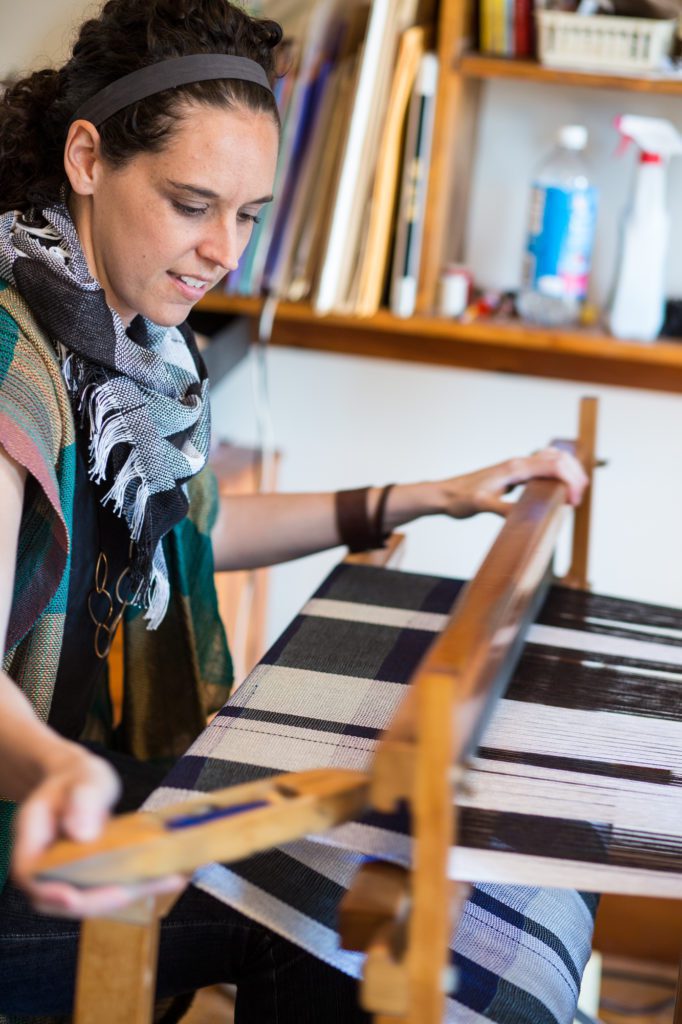How to decide what kind of loom to buy
Are you trying to decide if you want to get a floor loom or a Mirrix, and wondering what’s the difference? As an owner and user of both, I’m going to share the similarities and differences between the two.
First we’re going to talk about a floor loom. I’ll always have a special place in my heart for a floor loom, as that’s what I learned on and used exclusively for many years.
- First and foremost that is a con, they take up a lot of space and aren’t easy to move. Yes, they do come in a variety of sizes, but they are never going to be as small and portable as the Mirrix.
- Floor looms come with 2, 4, 6, 8… or so on harnesses. The more harnesses you have, the more complex weaving patterns you can create. This is an advantage to a floor loom in the event that you want to do more than just tapestry weaving.
- You can put a lot of warp yardage onto a floor loom at once. For example, I usual put 9 yards on mine, which means that you can make really big pieces, or you can set up once and make a lot of smaller pieces.
- For a floor loom, you need to purchase a separate piece, called a warping board, to get your yarn ready to go onto the to the loom. With the mirrix, you can jump right in and start setting up the loom.
- The warping process for a floor loom is much more complex and harder to learn than the mirrix. After watching one short video, I was on my way with the mirrix, we aren’t even going to talk about how long it took me to set up my floor loom for the first time.
- Floor looms are designed for weaving fabric, so things like scarves, tablerunners or fabric that you want to then use to sew into something else. They are less ideal for tapestry weaving, as it can be pretty tricky to keep the tension correct, and even harder to make any adjustments. ( Picture having to hang gallon jugs of water from your warp to adjust the tension)

After weaving exclusively on a floor loom for years, I became interested in tapestry weaving, and was pretty excited to give a Mirrix a try. Here’s why I’m loving it.
- The set up is super fast and easy
- It requires very little space, and is easy to store in a closet when I’m not using it.
- It’s easy to transport, which I love. If you love weaving, traveling can always feel like a bit of bummer, you’re inspired by your new surroundings, but unable to create. You can take a small mirrix with you, wherever, and create on the go.
- The tension is AMAZING….. and so easy to adjust as needed. ( If you’ve never woven on a floor loom, then just trust me, it’s amazing)
- I like using the mirrix for small pieces. It’s actually quite a challenge to create small pieces on my 36″ floor loom…. the tension is terrible when a piece gets too small.
- I do find the mirrix to be a bit slower because you’re using your hands to both weave and to switch the shedding device back and forth. ( however, I’m pretty sure that adding a foot treadle to the Mirrix could really spead things up)
- The Mirrix is also great for kids, they can quickly learn how to use it, and it’s a tool that they can keep and continue to use their entire life. While there are some less expensive looms for kids, kids tend to outgrow them but they won’t outgrow the mirrix.
So when you’re deciding what kind of loom you want to get, here are the tops things to think about.
1. What types of things do you want to create? If you want to make scarves and the like, you’re going to be happier with a floor loom. If you want to do tapestry, go for a Mirrix.
2. Space: A floor loom really needs it’s own dedicated room. A mirrix can move wherever, so it’s perfect for a small space.
3. What’s your experience with weaving and set up? If it’s little to none, go with a Mirrix. I”ve yet to meet someone who could figure out how to set up a floor loom on their own, which often means that people buy floor looms and never use them. The Mirrix really is an easy set up.
